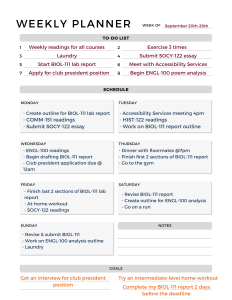Chapter 4: Learning Strategies
32 Weekly Calendars
One of the important ways to tackle your busy and demanding life in post-secondary is to plan out your time and schedule. For most people, the best way to do this is to create and fill in an actual calendar (on paper or electronically) that marks out your class times, other appointments and commitments, and designates time for your other responsibilities and activities such as studying, course work, hobbies and socialization, childcare, cleaning/housework, appointments, work, exercising, and sleeping.
Weekly Calendars
A weekly calendar outlines your commitments and priorities one week at a time. Play around with your weekly schedule to see how much information you want to include in it. Do you want to block off travel time to appointments or classes? Do you want to block off time for eating or personal care? Do you want to schedule every 15-minute block and assign specific course work to each day, or are you able to use a more flexible scheduling system? What has worked for you in the past? What are some of your stumbling blocks when following a schedule?
In addition to scheduled class time when you are expected to be in class or online, you’ll also want to schedule time each week for coursework. Many first-year classes have 3-6 hours of in-person (or online) lecture, lab, or seminar-style classes each week in addition to class readings and assignments that you have to work on in your own time. To start with, budget 8-10 hours per class into your weekly schedule. Add in extra time for any subjects that you think you may need extra time for readings, assignments, or other coursework. Track your time during your first few weeks and adjust your schedule accordingly!
Aside from your academic responsibilities, it’s also necessary to equally consider and prioritize other aspects of your life, such as personal and social activities. Non-academic commitments and responsibilities deserve space in your weekly calendar as well! It’s common for many students to unintentionally de-prioritize and neglect these other areas of life upon beginning post-secondary, as the consistent demands of academic life can pressure you to study, work, and learn around the clock.
Your weekly schedule is a great place to record and:
- Keep track of classes
- Protect time for sleeping, eating, cleaning, and exercise
- Allocate time for your friends, family, and relationships
- Choose when to work on specific tasks
- Plan for flexibility and time to build on your relationships

Strategies For Creating An Effective Weekly Schedule:
1. Be realistic about what you can accomplish in a day.
- Instead of setting unrealistic standards by overworking or over-committing yourself to an unreasonable number of daily tasks, allocate time gaps for relaxing, travelling, eating, napping, etc. (Believe it or not, limiting your daily tasks will make you feel more productive and motivated!)
2. Set your priorities.
- What must be done this week based on your list of priorities? This list shouldn’t be too exhaustive. Avoid overwhelming yourself, as this can lead to burnout.
- Don’t just mark down assignment due dates/test dates; decide on a day to start working on/studying for said assignment/test so that the due date doesn’t get lost amid your other goals and responsibilities.
3. Plan your week before it starts; you should always be planning a week ahead.
- Getting a head start on your weekly planning will help reduce your stress and last-minute coordinating because you’ll already know what you need to have prepared/get started on when your week starts (doing this on Sunday night will help get your Monday off to a good start).
4. Don’t be afraid to say no.
- It’s okay to turn down an invitation, drop a course, or decline a club position if it means giving yourself time to address your own needs, such as catching up on sleep, cleaning/decluttering your space, or spending more time on different priorities. You don’t need to do everything.
5. When scheduling tasks, consider what time of day works best for you.
- Are you most alert and productive earlier in the day and become less proactive in the evenings? Or, do you prefer working in the later hours of the day and enjoy using your mornings/early afternoons to complete lighter, less demanding tasks? Once you begin to understand your energy levels throughout the day and when you feel the most focused, you can decide when in the day to complete difficult and substantive versus light and passive tasks.
6. Get specific.
- Rather than vague tasks like ‘start project’, identify specific tasks such as: “tomorrow from 10-11am, research and select 3 articles to use for my COMM 150 project”.
- Use the Assignment Breakdown template to help you
Programs such as Google Calendar allow you to easily create different calendars for different aspects of your life that you can view simultaneously or separately. Google Calendar, among other similar programs, also allows you to assign different colours to different types of events/tasks.
Video: Getting Started with Google Calendar
Watch the video “How To Use Google Calendar (2022)” to learn more about the weekly scheduling tool.
Activity: Setting Weekly Goals
Think about the different areas of your life that take up your time on a weekly basis, which can be academic or non-academic. Think of 2 hypothetical weekly goals for each. Add these goals into a weekly calendar.
Consider the following:
- When should they be accomplished ?
- How long they will take ?
- How you want to break up their completions throughout your week ?

